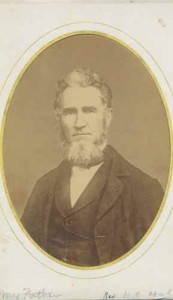« Reverend John Judson Steadman | Main | Abstract from Connecticut Church Records 1630-1920 LUKE HALL/RUBY PEASE HALL »
Reverend Hezekiah Cooley Hall
By Kathryn Hall | September 6, 2015
Hezekiah Cooley Hall was the son of Luke Hall, Jr. and Ruby (née Pease) Hall. He was born 9 May 1810 in Smyrna, Chenango, New York, two years after the birth of his brother Daniel Spencer Hall (b. February 1808). His surviving siblings at the time were Luke Hall [III], Ruby Hall, Fanny Hall, and Flora Hall. Hezekiah married Lydia Almira York 5 November 1852 in Brookfield, Madison Co., New York. He died 16 February 1872. They had three children. He is buried in Cedar Green Cemetery in Clayton, Gloucester, New Jersey. The back of his gravestone reads Rev. H.C. Hall.
Hezekiah’s wife, Lydia Almira (York) Hall, b. 29 March 1822, was the daughter of Ichabod and Freelove (Gardner) York. Lydia graduated from Cazenovia Seminary in 1848 and was a teacher at Brookfield Academy. She was Preceptress of Onondaga Academy at Manlius, New York and Preceptress at Silver Creek Academy, Silver Creek, New York and later Superintendent of the Mission Schools among the Onondaga Indians of the Onondaga Reservation. Lydia died 26 September 1892.
From Hezekiah’s obit:
Birth: May 9, 1810
New York, USA
Death: Feb. 16, 1872
Clayton
Gloucester County
New Jersey, USA
Rev. Hezekiah C. Hall was the son of Luke and Ruby (Pease) Hall. He was the husband of Lydia Almira (York) Hall. He was a minister in the Oneida Conference and Central New York Conference of the Methodist Episcopal Church. [See notes below. KH] He served in the ministry for 28 years.
Obituary
Northern Christian Advocate
March 14, 1872
HALL.–Hezekiah C. Hall of the Central New York Conference, died in New Jersey, February 16th, 1872.
Bro. Hall was born in Smyrna, New York in 181O. At the age of twenty-four he gave his heart to God and joined the Methodist Episcopal Church. His love to God and souls was such, and feeling called to the ministry, he joined the Oneida Conference in 1844, and was stationed at East Homer. After nine years of labor, his health was such that he took a superannuated relation for four years. His health improving he took a charge, and was in the effective ranks for nine years more. His last charge was at DeRuyter and Sheds Corners. After laboring here for about six months his health entirely failed. His sufferings were severe for months when he recovered so as to be about the house. He had been afflicted with sciatic rheumatism for years, which at times caused intense pain, but such was his love for the work, and his ambition to do what he could, that on one charge he was obliged for weeks to go on his crutches to the church, and then sit down to preach. About five years ago, hoping a change of climate might help him, he removed with his family to New Jersey, a few miles north of Vineland. But he only partially recovered, and to add to his sufferings he was thrown from a wagon, dislocating his hip, which not being properly set, caused him increased pain. When I visited him last fall, I found him able to walk about some, but only the wreck of his once strong and manly form. But his faith in God was strong, and he was looking for the time when his sufferings would end, and he be at rest. He retained his reason till the last, and died in the full hope of a blissful immortality. “Our people die well,” and the Gospel which he preached, now sustained him. His funeral was attended at the Methodist Episcopal Church in Clayton, and he was buried there. He leaves a wife who for nearly twenty years has shared with him the joys and trials of life, and three children.Written by Rev. William E. York
Tully, March 2nd, 1872
History of Cazenovia College [Oneida Conference Seminary]
Cazenovia College traces its birth to 1824, when it was founded as the Seminary of the Genesee Conference, the second Methodist seminary to be established in the United States. It opened in what had been the Madison County Courthouse.
Although sponsored by the Methodists, the seminary was nonsectarian, and its trustees were a mixture of clergy and laymen. Financial support came not only from church members but also from forward-thinking local residents who recognized the seminary’s beneficial effect on employment, the general economy and the cultural life of the village. The community’s continuing interest in the seminary and the College cannot be overestimated.
The seminary was a pioneer in coeducation. From the beginning it welcomed both men and women who wanted to prepare for college or complete their education in Cazenovia. In two years there were 145 students.
Rooms in the residential facilities were 11 feet square and cost students $1 per week. The buildings housed both men and women, but strong doors divided the two areas.
Distinguished alumni include Jesse Truesdell Peck, a founder and first president of the board of trustees at Syracuse University; Charles Dudley Warner, editor of the Hartford Courant and close friend of Mark Twain; and Leland Stanford, who founded and endowed Stanford University of California, served as a United States senator and governor of California, and was president of the Central Pacific Railroad. When America’s first transcontinental railroad was completed, it was Stanford who drove the golden spike where the two rail sections joined in Utah.
Over the years the seminary changed its name several times, first to the Seminary of the Genesee and Oneida Conferences, later to the Oneida Conference Seminary, then to the Central New York Conference Seminary. In 1894 it became Cazenovia Seminary. Between 1904 and 1931 the institution also functioned as a secondary school for young people from the township, an arrangement that ended when Cazenovia Central High School was built.
Topics: New York | No Comments »



